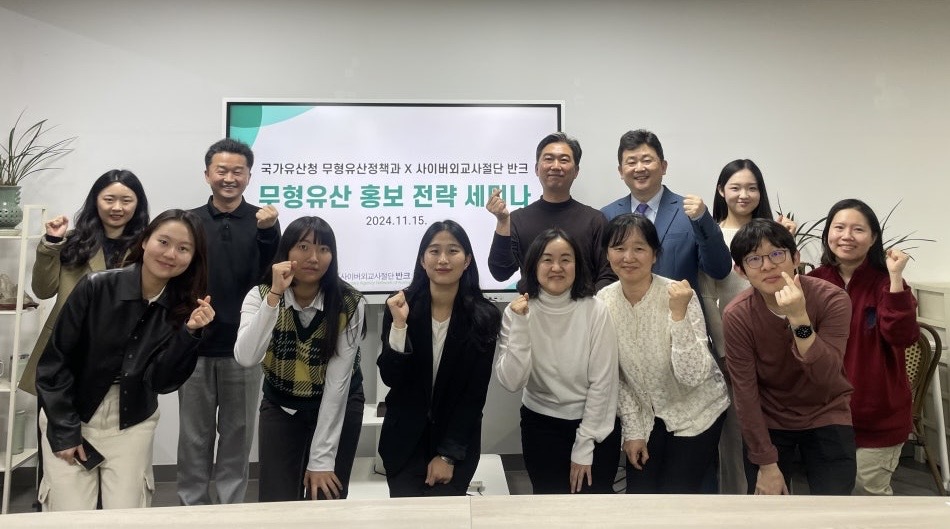
On November 15, 2024, at 4 p.m., the Voluntary Agency Network of Korea (VANK) hosted a seminar in its conference room in collaboration with the Korea Heritage Service’s Intangible Heritage Policy Division to explore strategies for effectively promoting Korea’s intangible cultural heritage worldwide.
The seminar was designed to highlight Korea’s national intangible heritage and identify ways to present it accurately on the global stage. The event began with a presentation on the achievements of VANK’s global promotional campaigns.
VANK researcher Kwon So-young introduced the results of collaborative campaigns between VANK and the Korea Heritage Service, particularly campaigns promoting the five major traditional holidays—Seollal, Daeboreum, Hansik, Dano, Chuseok, and Dongji—as well as initiatives responding to cultural distortions originating from China. Kwon emphasized, “VANK will continue proactive campaigns to raise awareness and protect Korea’s national heritage worldwide, beyond short-term responses,” highlighting the importance of close cooperation with the Korea Heritage Service.
In the following session, VANK researchers presented various ideas for promoting intangible heritage, which were further refined through feedback from officials at the Korea Heritage Service.
Youth researcher Koo Seung-hyun proposed the “Discover Intangible Heritage in K-Content” campaign. This participatory initiative encourages the public to identify Korean intangible cultural heritage featured in dramas and films, rediscovering endangered traditions. Koo explained, “Linking traditional culture naturally with K-content provides significant promotional value.” He suggested a monthly quest event, “This Month’s Intangible Heritage Discovery,” where participants could recommend and share heritage elements found in media, allowing broad public engagement. The most popular heritage items each month would be highlighted, and highly notable examples, such as the women’s theater featured in the drama Jeongnyeoni, could be promoted through dedicated videos to leverage popular K-dramas as a tool for global heritage awareness.
Youth researcher Seong Hye-seung emphasized improving accessibility through integration with national archives. “When searching for lesser-known traditions like gukgeuk online, official information is scarce,” she noted. While gukgeuk is not officially designated as national intangible heritage, its limited documentation may hinder Hallyu fans’ understanding. She also highlighted endangered practices such as badijang, whose preservation is threatened due to a lack of practitioners, and proposed consolidating scattered materials and providing institutional, legal, and image links to enhance accessibility. She stressed that linking historical and cultural materials is not merely a matter of data, but a foundation for understanding and preserving Korea’s history and identity.
Youth researcher Kim Ji-hye proposed an intangible heritage quiz campaign via social media, allowing participants to learn heritage names and images naturally while strengthening knowledge and awareness. She noted, “Creating multilingual quizzes will make it easy for foreigners to learn about Korea’s intangible heritage.”
Researcher Yang So-hee suggested producing Instagram stickers based on intangible heritage images from VANK’s promotional materials. “These stickers could be used in stories, comments, and other social media features,” she said, expressing high expectations for engagement.
Researcher Kwon Soon-gyu proposed creating multilingual social media platforms to improve foreign accessibility. “Although the Korea Heritage Service website provides detailed descriptions of our intangible heritage in English, Chinese, and Japanese, social media content is primarily in Korean, making it difficult for foreigners to access,” he said, stressing the need for joint SNS campaigns with VANK.
Senior researcher Lee Sun-hee proposed the “Discover Local Intangible Heritage” event. “Creating content to showcase regionally significant heritage, such as Arirang variations or Jeju haenyeo, and running comment-based events will help uncover lesser-known heritage,” she said, emphasizing the potential to boost public interest and local pride.
Lee, who trains youth ambassadors to promote Korea globally, also suggested developing “Intangible Heritage Ambassadors” among youth. “If youth diplomats at VANK learn about national intangible heritage in detail, they can promote it accurately worldwide,” she said, requesting educational video materials from the Korea Heritage Service’s Intangible Heritage Policy Division.
VANK Director Park Ki-tae highlighted the importance of the seminar, saying, “Cooperation between VANK and the Korea Heritage Service is a significant step in promoting Korea’s intangible heritage globally. Intangible heritage is not merely about preserving traditions—it is a powerful medium to convey Korea’s history and identity worldwide.” He added that the ideas proposed at the seminar would develop into effective global promotional strategies.
Cho Dong-joo, head of the Korea Heritage Service’s Intangible Heritage Policy Division, said, “The partnership between VANK and the Korea Heritage Service represents an ideal collaboration that combines the strengths of the public and private sectors. We appreciate VANK’s deep interest and efforts in promoting national intangible heritage.”
Building on this seminar, VANK and the Korea Heritage Service plan to hold regular events to promote Korea’s national intangible heritage globally and to implement the proposed ideas. VANK stated that the seminar was a pivotal moment in uniting the visions of both organizations, and that, in the era of 200 million Hallyu fans worldwide, Korean pop culture will expand to encompass Korea’s history and heritage, with national intangible heritage taking a central role in global awareness.